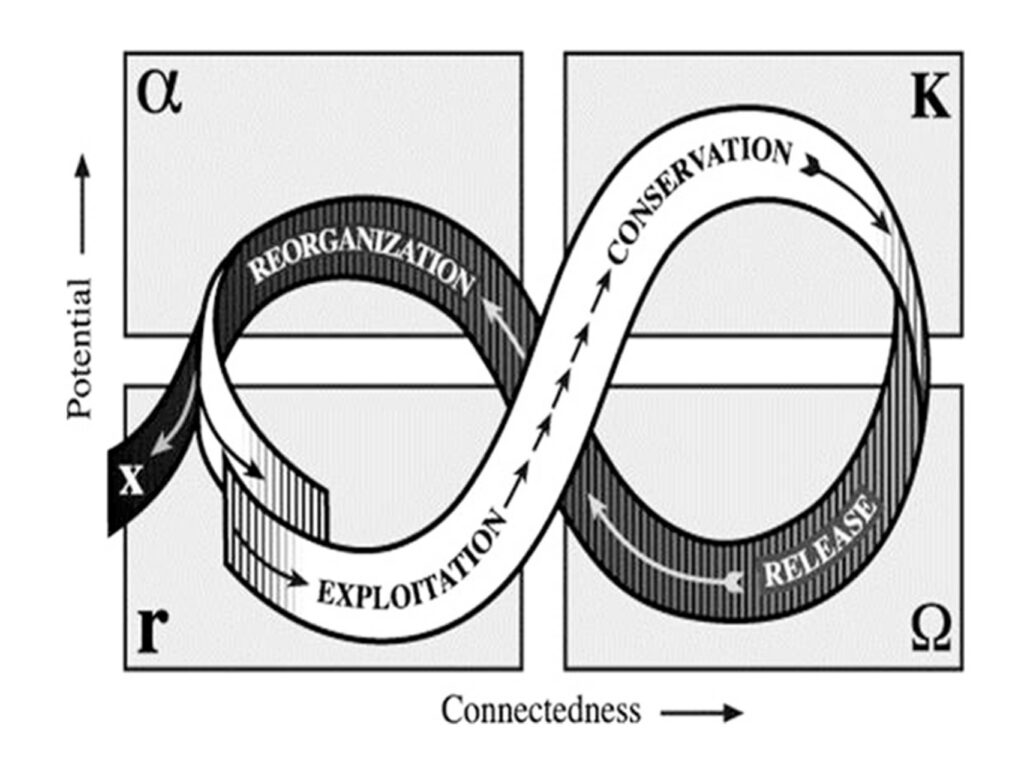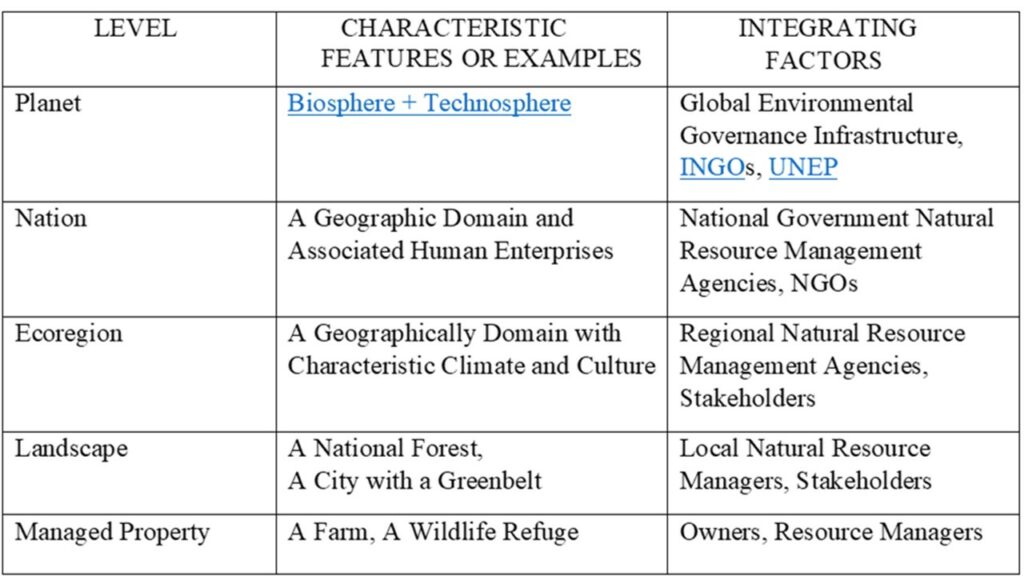
David P. Turner / September 14, 2021
Think of the entire global human enterprise as a system − what Earth system scientists are beginning to call the technosphere. It consists of all the material artifacts and energy flows associated with our global high technology civilization, as well as all the social bonds and institutions that tie us together. A high degree of connectivity is evident in the technosphere (Figure 1), and it is worth asking if more connectivity (e.g., a stronger United Nations) or less connectivity (e.g., effects of anti-globalization) would help in the struggle for global sustainability.
Systems are often specified in terms of parts and wholes, and in terms of interactions between the parts that help maintain the whole. The quantity and nature of these within-system connections have long been of interest to systems theorists because of their influence on system stability. The connectivity concept offers a lens through which to view technosphere structure and function.
In the ecological literature, (eco)system connectivity has two aspects. One is geographic (2-dimensional) – as in corridors across a landscape that allow movement of animals or dispersal of seeds. High connectivity is important because, for instance, after a disturbance such as fire, early successional species must find their way to the disturbed patch.
The second aspect of ecosystem connectivity relates to the way processes are coupled. In a highly connected forest ecosystem, the processes of decomposition (which releases nutrients) and net primary production (which requires nutrient uptake) are coupled by way of a network of fine roots or mycorrhizae. In a weakly connected tree plantation, where a significant proportion of nutrients are provided by fertilizer, that coupling is missing. High connectivity of processes usually means more effective system regulation.
In the technosphere, geographic connectivity is maintained by the transportation and telecommunications infrastructure. Process-based connectivity relies on coupling between sources and sinks of energy, materials, information, and money.
Technosphere connectivity has grown increasingly dense over time (Figure 1) with a corresponding rise in technosphere mass and energy throughput. All that global connectivity has helped raise standards of living for billions of people. But the technosphere is showing signs of self-destructiveness, and it is worth asking if it is in any sense underconnected or overconnected.
Ecologist C.S. Hollings has argued that late successional ecosystems become overconnected. In his panarchy model for ecosystem development, a four-stage cycle (Figure 2) begins with a catastrophic disturbance (Release phase). The disturbance stimulates decomposition of dead organic matter and frees up resources for colonizing species that seed in and rapidly accumulate biomass (Reorganization Phase). As the ecosystem fills in (Exploitation or Growth Phase), the connectivity increases (note the x-axis). In contrast to earlier theories of ecosystem dynamics, Hollings suggested that ever increasing ecosystem connectivity may ultimately be destabilizing because nutrients get locked up in biomass, and a high density of organisms means strong competition that stresses the organisms and makes them vulnerable to disturbance (Conservation Phase). Eventually, the stressed condition of the biota allows another major disturbance, such as an insect outbreak (Release Phase), that sweeps across the ecosystem and restarts the panarchy cycle. The Reorganization phase is a period of low connectivity, leaving the ecosystem susceptible to degradation.

The technosphere system is like an ecosystem in having a throughput of energy (mostly fossil fuel) and a turnover of its components. It has certainly gone through a growth phase (often referred to as the Great Acceleration) and is now accumulating connections rapidly as it matures. Let’s place it somewhere between the Exploration and Conservation phases in Figure 2. It might be underconnected in the sense of weak links between different geographic areas (e.g., in the face of global scale problems like climate change) and limited coupling of critical processes (e.g., mobile phone manufacturing and mobile phone recycling). The opposite concern is that it may at some point become overconnected and vulnerable to a major disturbance.
Let’s examine ways in which the technosphere could be considered underconnected.
1. An underconnected technosphere is one in which global scale coordination is unable to meet the challenges of Earth system maintenance. Lack of connections allows global scale problems to escape technosphere control. The situation with global climate change evokes this sort of underconnection. In broad terms, we have inadequate institutions for global environmental governance (not to mention global economic governance). The shambolic global response to COVID-19 is also indicative of underconnection; a better coordinated global vaccination program would have been in the best interest of everyone.
2. The technosphere is causing massive disruption of the biosphere and Earth’s climate. These impacts on the Earth system are associated with failure to fully recycle technosphere “waste products”, e.g., the production of carbon dioxide by fossil fuel combustion is not connected to the removal of carbon dioxide from the atmosphere by some other industrial process.
3. A renewable energy revolution is clearly needed to mitigate climate change, but the sources of renewable energy (e.g., wind and solar) may not be co-located with the demand for energy (urban areas). Hence, a more robust grid (nationally and internationally) for distribution of electricity is required (along with other energy infrastructure upgrades).
4. We think of the global Internet as foundational for global connectivity. And, in fact, the Internet facilitates the kind of global coordination that is needed to address global environmental change issues that threaten the technosphere. However, nations such as China and Russia have built national Internet firewalls that prevent their citizens from freely accessing the Internet. That kind of fence raising promotes nationalism, but not the planetary citizenship we need to create a sustainable future.
The case for an overconnected technosphere is less compelling. The rapid spread of the 2007-2008 financial crisis around the planet is suggestive of fragility in the global economy. And the crush of 7.8 billion people striving for a high quality of life is contributing to widespread stress in the biosphere (upon which the technosphere depends). Ironically, solving these problems may require greater international connectivity.
We are still in the early stages of technosphere evolution, and my sense is that greater global connectivity is desirable. With regard to the global environment, we are in dire need of 1) a well-connected circular economy that recycles all manufactured products, and 2) new international institutions for global environmental governance that coordinate monitoring, assessments, adaptation, and mitigation of global environmental change problems. The anti-globalization movement calls for less connectivity but the proliferation of global scale problems points to the need for more connectivity.
Recommended Reading: Connectography: Mapping the Future of Global Civilization. Parag Khanna. 2016. Random House. My review.



